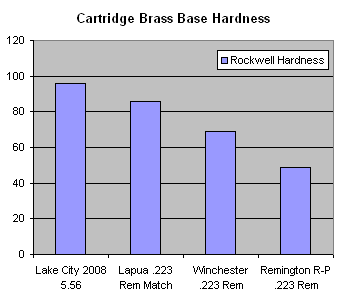CRaTxn
Well-Known Member
Measuring the fired case just above the extractor groove doesn't tell you the chamber pressure. All it tells you is how hard the brass is in the base of the case and how the chamber pressure effects the brass.
How Hard is Your Brass? 5.56 and .223 Rem Base Hardness Tests
http://bulletin.accurateshooter.com...r-brass-5-56-and-223-rem-base-hardness-tests/
Below the Remington brass will expand more in the base than the Lake City brass at the same chamber pressure.

Also the thickness of the flash hole web will effect the amount of base expansion, and why they say Federal brass is soft.

Bottom line, measuring the base diameter tells you is the strength and elastic limits of the brand of case you are using and how much pressure it can take.

>>>>>>>>>>>>>>>>>>>>>>>>>>>>>>>>>>>>>>>>>>>>>It can be used as an indicator of excess pressure, however, the variables related have to be controlled with certainty. I used this method for a while and finally abandoned it as it wasn't giving me the information I was looking for until after I got back from the range.
You won't be able to extrapolate between brand A and B brass, or even different lots, until you know the elastic limitations of each.
The problem I have found with this methodology is that it requires you to shoot loads that are quite certainly too heavy, so you can check to see if you've exceeded the elastic limitation of that lot of brass.
The manufacturers ability, or desire to control QC variables among the particular lot HEAVILY influences your results. This is where I threw in the towel on this method. I had a load that I worked up in ten pieces of X brass. I labeled each case 1-10, shot a seating test and measured each case. Then shot a ladder test and measured each case. I then loaded all ten of those cases with the same load, fired them and measured the cases. I thought everything should be good to go, as I've fired, loaded and measured these ten cases three times. When I loaded the other 90 cases with the same load that was 'safe' in the previous sessions I found out the hard way that I wasn't. The next session at the range, with three of my respected friends there, I fired two rounds and the third round lost the fired primer into the action of my rifle jamming the bolt and ending my day at the range. I took the whole mess home and cut the failed case apart to see why. The failed case was 0.009" thinner at the web the other fired case I cut apart. I then cut three more cases and found a total difference of 0.011". I called X and their customer support basically said not our problem, they were within their manufacturing QC controls.
Also without a chamber casting you don't know a thing other than the diameter of the brass at the time you measured it
Amen...each chamber also has its size tolerances and will effect fired case dimensions. With the same brass that had perfect consistency possibly firing a normal load and miking expansion vs a heavy load expansion would have some validity BUT the assumption of the same brand brass being consistent is INVALID. Don't push your brass [ that is your safety you are dealing with ]...if you think you must have more velocity, buy a different caliber.
